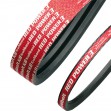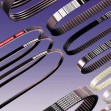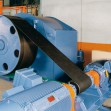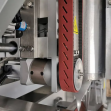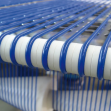V-belts are used in various industries as a reliable means of transmitting torque between shafts. The transmission of torque in a V-belt drive occurs through the friction between the belt's side edges and the grooves of the pulley. This method of energy transmission allows for the transfer of high loads over long distances.
V-belts have wide applications in industries such as machinery manufacturing, mining, oil, agricultural machinery, and more.
Types of V-belts and their main advantages
- сlassic V-belts. A reliable and time-tested solution for torque transmission;
- wedge V-belts. They have a smaller aspect ratio compared to classic V-belts, offering better flexibility and higher operating speeds;
- raw edge V-belt They can be installed on small-diameter pulleys and provide a high transmission ratio;
- They inherit all the advantages of V-belts and can handle higher loads due to a larger contact surface area;
- ribbed belts. They combine the flexibility of flat belts with the high efficiency of V-belts;
- variable speed belts. An ideal solution for applications requiring variable speed transmission.
If you need consultation regarding the advantages of specific belt types or assistance in selecting the appropriate V-belts, we recommend contacting of the company Beltimport.

